Aries Cerat Heléne DAC and Incito S preamp
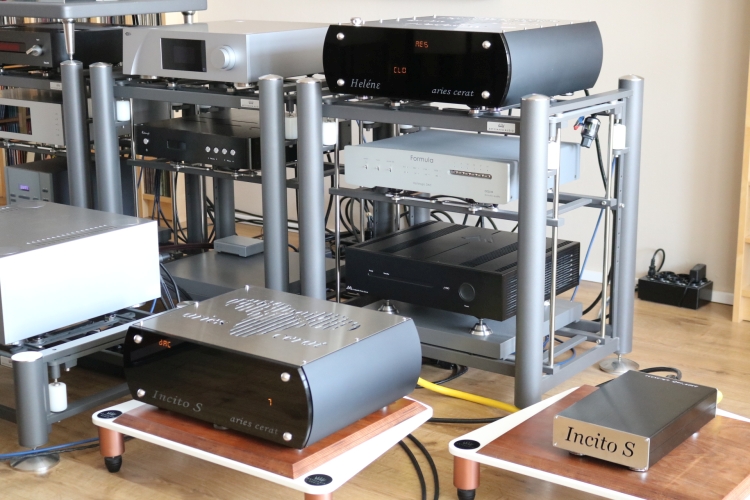
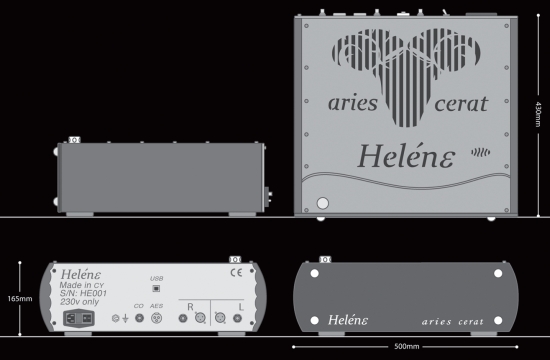
Technical Matters – Heléne DAC
The Heléne is the company’s latest and “smallest” DA converter. Smallest? That’s definitely relative because the Heléne is 2cm wider and considerably deeper than the Incito S preamp and when set up next to the CH Precision C1 DAC, the Helene’s sheer bulk makes the already hefty Swiss DAC look almost cute. That’s the thing with Aries Cerat components, only when you see them in person do you realize the scale.
Borrowing technology from the Kassandra Series, and with the addition of some tricks of its own, the Heléne is intended to set a new benchmark for performance in its price range. Descending from Kassandra Series, the converter banks are implemented around a matrix of eight Analog Devices AD1865NK R2R ladder DAC IC’s per channel, running in parallel and in current mode. These are driven by custom logic that handles the sync, data, and work buses. The SuperClock technology used in the bigger Aries Cerat DAC models is also standard in the Heléne DAC, according to the manufacturer, negating the need of an external aftermarket Word Clock. The USB input, as well as the digital inputs, are double Reclocked using the internal SuperClocks. This is enabled for 44.1kHz or multiples only. Non-synchronous sample rates such as 96kHz are converted directly. No matter the input signal, however, the converter uses no data processing, upsampling, or oversampling, data is converted in the native sample rate and bit rate. For USB, Reclocking is always enabled while the user can manually select double reclocking or bypass for the other inputs on the fly.
As I found when using the Grimm MU1 as I always do, no sound was heard. Only after a bit of head-scratching and the use of another digital source, did I realize that the MU1 was set to 4x oversampling. With a 44.1kHz source, this resulted in a 176.4kHz stream that the Heléne’s AES/EBU input does not accept. Some experimentation showed that it does accept 88.2kHz, so I’m guessing that the S/PDIF and AES/EBU inputs are limited at 96kHz as per the older standard. The USB input does accept a much higher sample rate, up to 32bit 384Khz according to the website.
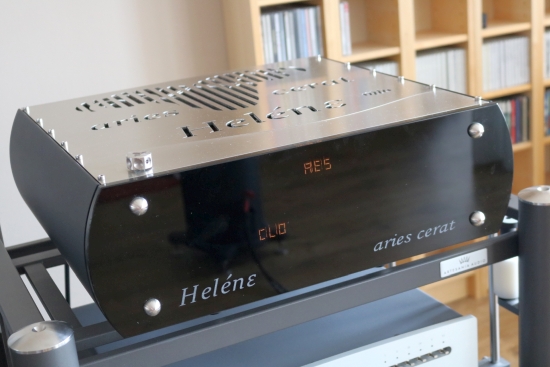
Unlike the preamp, the DAC has no remote control. The inputs and the use of the Reclocker can be selected by the rotary dial on top.
The power supplies for both the digital and analog sections are carefully designed around massive capacitor banks and extensive RF choking filters that are distributed to all local points of the circuit.
The IV (current to voltage) stage that follows the DAC outputs is implemented in the purest possible manner by a special IV transformer with a custom ultra-high MU core, directly modulating the bias circuits of the analog tube stage.
The Heléne DAC has a relatively high-level voltage output but the unit is fitted with a -6dB switch that prevents clipping of very sensitive preamp input stages. With the Incito S preamp, I encountered no clipping at all but I did find that it was better to use the lower output in order to have enough steps left in the volume control’s lowest range.
The analog stage is a small SET amplifier, again borrowed from the bigger models, built around two E280F supertubes, loaded by a custom special quality output transformer. The power supply for the analog stage uses tube rectification via the GZ34 rectifier, while triple choke/film capacitors provide very low noise voltage rails for the SET amplifier.
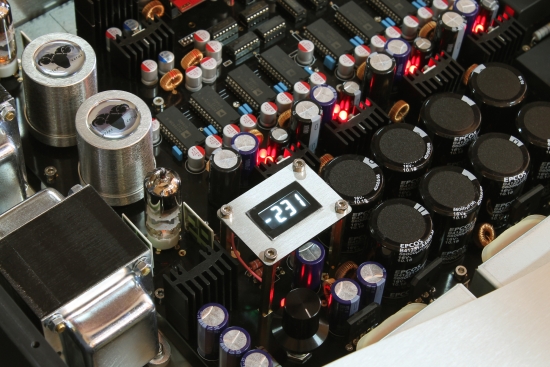
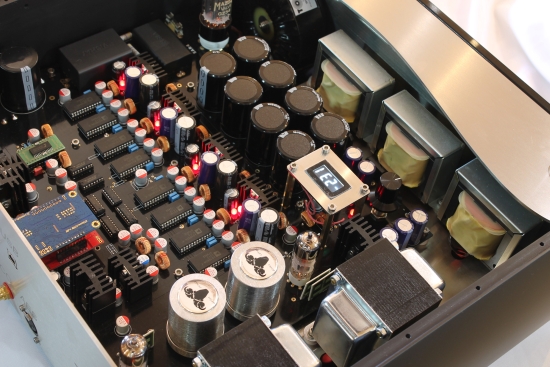
The tube is biased with triple-filtered ultra-low-noise bias circuits. If desired, the user can alter and monitor the bias for the left and right tubes simultaneously by the use of a variable potentiometer and a built-in display that can be seen through the top panel slits. The value should read between 180 and 290 and ideally 230.
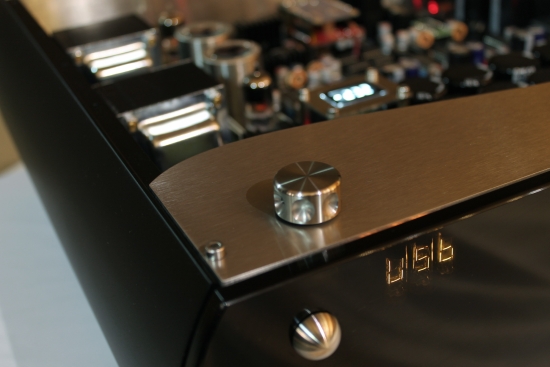
The Heléne’s thick black glass front panel hides a row of Nixie tubes, chosen for their lack of noise.
The DAC offers both single-ended and balanced inputs and outputs. As with other components that do not use separate buffers for multiple outputs (for purity reasons), one should not use RCA and XLR output at the same time. There’s a ground switch that should be set in the lift position (not pointing to the earth symbol) when using the XLR outputs or when there are ground loop problems.
The tube life is indicated as 3000 hours for the rectifier tube and in excess of 9000 hours for the E280F.
Ron informed me that the E280F cost around 25 euro while the GZ34 cost 41 euro in the market. He added to expect a much longer lifetime service from the tubes than indicated by the manufacturer.
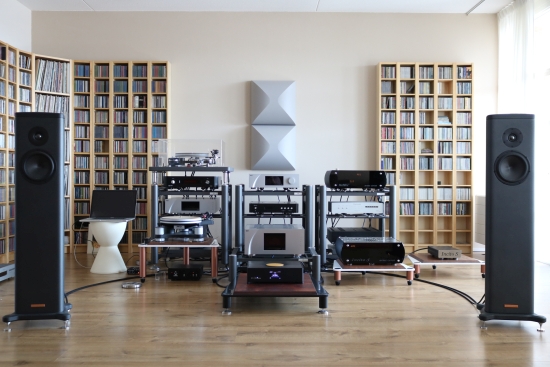
System Context
For this review, I used my main system, in the basis consisting of the CH C1 DAC, CH A1.5 power amp, and Magico S1 MkII speakers. For digital sources, I will use the Grimm MU1 and Antipodes K50 music servers, the Aqua Formula xHD DAC (with v2 output board), and Aqua LinQ network interface (with the Core+NAA module). In all cases, I will use the AES/EBU connection. After forming my initial impressions I will also involve the Heléne’s USB input in a separate section.
In order to fully test the Aries Cerat components, I will use them as a complete front-end duo as well as individually. To this end, I will compare the Heléne DAC and Incito S preamp combo directly to the CH Precision C1 DAC, both simultaneously connected to the A1.5 power amplifier. Secondly, I will compare the Heléne DAC to the very similarly-priced Aqua Formula xHD DAC with V2 output stage, and finally, I will add the Incito S preamp between the C1 DAC and the A1.5 amplifier.
Warming Up
As Ron learned from using passive TVC preamps, the running-in of a transformer is something to really take into account. Prior to handing the equipment to me, he made sure to have given the components plenty of running in with all connections, both RCA and XLR. He even went as far as to run in the preamp’s TVC using all of the volume settings within the normal listening range.
As I mentioned, I was given the green light to leave the two components switched on for the duration of the review and of course, I did so. It’s only fair since I do the same with my CH components. However, it must be said that I did not notice very much of a difference between a cold state and a warmed-up state. Even when cold, the Aries Cerat components sound highly detailed and musically appealing in equal measure, and that balance does not waver with further warming up.
Reclocking
The Heléne DAC offers Reclocking using its internal “SuperClocks” and for all inputs except USB, this process can be manually switched on or off. Naturally, I listened to both settings and found that the bass becomes slightly tighter and the entire delivery a little more controlled. The non-clocked setting sounded comparatively slightly more free-flowing but also with a slightly lower sense of pacing. Given the Heléne’s already rich sound as well as my natural preference for clean bass, I preferred the DAC with the extra clocking enabled and so I used it like this for the entire review.

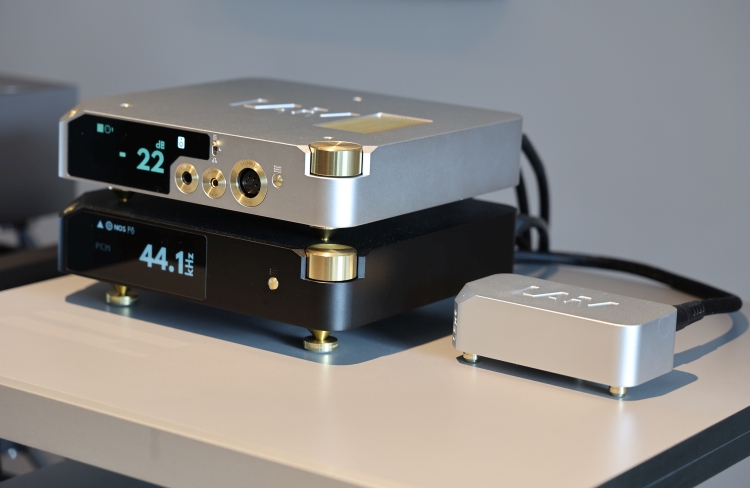





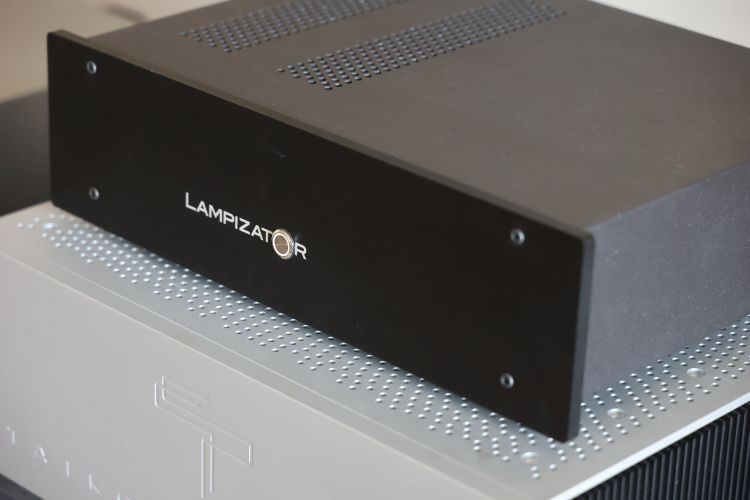
Christian,
Great review on a brand I’ve heard a little about but never seen a review of. And you’ve certainly proven what are some truisms for me, a preamp is crucial to ultimate sound quality, and all things being equal tubes are best. 😉 Now all things are rarely equal of course but that Incito preamp sounds pretty special I’ve always found a tubed preamp to have an outsized effect on overall sound quality. I doubt I’ll ever hear one but would love to.
Cheers,
Jon
Thanks, Jon, the Incito S truly is something else. And Ron tells me that the bigger preamp “walks all over it”… Gulp. I thought hard about which award to give it but even if I will have no higher praise than “Magnificent Masterpiece” to award, should I ever review the Impera preamp, I decided to award it to the Incito S.
Jon,
I discovered Christiaan’s website quite by chance recently. Since then, I stay tuned.
I am the very happy owner of an Aries Cerat *Incito* preamp (not the S version, so mine has an embedded power supply; the S version has a separate PS).
It easily replaced my YBA 1 preamp (which had a separate PS).
The Incito changed my system. That thing is not of this world. Period. Some say that Aries Cerat preamps are the only ones which decide the aficionados of passive preamps to abandon their fetish.
I attend to live concert regularly, so I do not like “typical” tubes devices (honey-topping on everything). This one is truly different. I was amazed by the amount of both body&liveliness, distinction&exuberance, flesh&transparency it could deliver. A dizzying ability to deliver qualities that other high-end devices have accustomed us to consider as opposites. Here, they are reconciled/synthesized with a stunning mastery.
Try to listen to one.
FYI, my *power amplifier* is a YBA Signature Classic stereo (100w), very “liquid”-sounding.
(I also listened to a whole Aries Cerat system, in a very good room: gobsmacking…)
Orfeo that’s very cool and quite a good system you have YBA is another brand somewhat underrepresented here in the US that I’ve never heard. The Incito sounds like an amazing piece of gear, I hope Aries Cerat will show their gear at US audio shows, whenever they start happening again. The Capitol Audiofest here in DC is my outlet for hearing gear I otherwise might now, And Orfeo may I ask what speakers you’re pushing with that lovely amplification stack?
Cheers,
Jon
P.S. Agreed Christian is one of the very best and most thorough reviewers out there.
Please allow me to report additional experiences with the Synergistic Orange fuses and Aries Cerat. The review mimics my own experience, and if it all stayed just like that it would be a very nice tweak to put it mildly. But after some week of daily playing, there is no less than a small transformation here.. the bold euphoric ‘technicolor’ impression at first date seem to shift into a more speedy, open and articulate sound. It sounds more balanced now, and all is like a wide open window onto the musical landscape. It may sound silly, but the Orange Fuses need playing… Both Genus, Incito and Heléne have the Orange in. Great stuff, highly recommended.
Thanks for the helpful feedback, Ron!
Wow THAT’s a review! Thank you very much Christiaan for the hard (pleasant) work such a thorough review must have required. Testing all combinations must have been very time-consuming.
Regarding the TUBES LIFECYCLE, I read in the review that
1. “the manual […] mentions avoiding frequent on-off switching of the unit to preserve tube life.”
2. “That’s why Ron simply always leaves them switched on and told me to do the same. I should note that in this case, the tubes will respectively last at most 250 and 375 days”
As a very happy owner of an Incito preamplifier since 2018, this grabbed my attention:
point 1: avoid “frequent” on-off switching. What do they call “frequent”? I always do max ONE on-off switch per day. I do not let the preamp burning all day when I am away. Moreover, I know that there are 5 chokes inside the Incito, so I suppose they damp the ‘brutality’ of on-off switches, don’t they? If so, what’s the point in keeping the device turned on? (except to avoid any warm-up time, which is a different issue).
However, regarding point 2, leaving the device ON permanently ensures the reviewer that the device plays at its full potential all the time indeed. Which is commendable, especially for a reviewer.
So, as far as I understand,
– if I leave the device ON all day, 24/7 => tube life=250/375 days (rectifiers/E280F, respectively)
– if I turn the device ON when I come back home, and OFF when I go to sleep => tube life=approx. 5 years, BUT a warm-up time has to be endured everyday. A warm-up of 30 min/1h is said to be sufficient, but not everyone agrees.
Am I correct? Or am I missing something?
Thanks.
Glad to hear you liked it, Orfeo! Indeed, this has been a lot of work, but when any question forms in my mind during a review, I NEED to investigate it and report on it. I can’t help myself…;-)
Regarding warm-up, in general, my experience is that 45 minutes gets you pretty much all the way there with most tube equipment, with small incremental improvements in the hours thereafter, for some equipment.
As for what constitutes frequent switching, that’s a great question but not one that I can answer. All I can say is that I personally prefer not to leave tube equipment on when I’m not listening to it. Typically, I have the Ayon gear switched on for around 5 hours per session but since they are in my secondary system, I only use it about once a week. The same applies to the Ayon Stealth that I use in combination with the turntables in the main system.
Perhaps Ron or Stavros are willing to get into more detail with regards to tube life versus power cycles.
Hello Orfeo
What is recommended, is turning the units on and off during your sessions, or maybe a few hours before. Though units can stay on 24/7 it is not really optimum for tube life.
What I would call frequent on-off, is the habit of very few people, turning on and off the units several times a day, listening for example for an hour, turning off, and then on again after a while.
Certainly 2-3 power cycles a day is far from calling it frequent on-off.
On turn on, though triple choke filtered, the rectifier is always having its roughest moment of the day 🙂
Cheers
Stavros
Tubes are a hotly debated topic. Of course, there are many different opinions, or different experiences. It is a choice to leave a tube DAC or Pre-amplifier always on or not. The suggested lifetime is just that; a suggestion, maybe a prediction. There are always extreme examples concerning tube lifetime, there are power amplifiers whose tubes after 25 years of continuous work still measure as new. Of course that is exemplary, and quite out of the ordinary. There are also known amplifiers that need new tubes about every year (..), and sometimes including the tube sockets. In principle it is a good idea to measure all tubes every (half) year, and to write down the values. Personally, I find it a bit too much to keep the Genus 813P in continuous operation, but the Incito and Heléne are fine for me. Only time will tell to what extent the GZ34 and E280F will decrease in measured values. It’s a balancing act, and for me personally, that choice is in favour of always leaving it on. As they say: Your Mileage May Vary. In the meantime; Keep spinning and enjoy the Music!
Are you using the preamp incito with the integrated amp genus. Is it advisable and does it make any improvement.
I have not tried this, so alas, cannot comment with any certainty. In general, I would not expect an integrated amp to very easily have a similar quality preamp on board as good as the Incito S. On the other hand, integrated preamps benefit of shorter signal paths and optimized circuitry. What I can also say is that pretty much any amplifier will allow you to hear the benefits of a better preamp. In fact, I’d rather have an expensive preamp and a less expensive power amp than the other way around. But ultimately, I cannot make any hard claims, only recommend to just try it.
I know from a VERY reliable source that
Incito preamp* + Genus P** does not quite equals a Genus integrated (because 1. shorter signal paths, as Christian said, and 2. identical volume control on both, i.e. relays).
*Incito preamp = ‘basic’ model, NON-S (=Prestige Series)
**Genus P = the POWER AMPLIFIER ONLY version of the Genus.
**BUT** if you consider the Incito S (=Reference Series) as a preamp, that becomes another story (the volume control here is better, with TVC system, that is based on a transformer; it is said to be the best volume control systems of all).
I have NO information regarding such a combination (Incito S + Genus P).
You don’t mention which gear you already own. But, as Christian said, yes, it is advisable to get the best possible preamp first, then see what you can later afford as a power amp, and which one does the best match with your speaker. This way, the preamp can become the tether of your system, the gear that will go along with you during all your audiophile life.
Happy listening.
Great reply, Orfeo!
Is de Dac Helene een meerwaarde voor mijn huidig systeem? Dit bestaat uit de Accuphase E600 en de B&W 803D3.
Is the Dac Helene an added value for my current system Accuphase E600 and B&W 803D3?
Hi Marc, I’m assuming you have the DAC board installed in the E600? In that case, the Helene will indeed have a lot to offer. What the converter board does very well is pacing, articulation, and dynamics. It’s not the best in terms of refinement, fluidity, and flow. And that’s exactly where the Helene does excel, among other things. Of course it depends on what you value most in the sound. In general, though, I’d say the Helene is considerably better. The only reservation against the Helene that I could think of is if you value bass tightness over all else. But that goes for a large majority of tube products.
Hi Christiaan. I want to know if Aries Cerat Dacs decode DSD. Although it´s rate samples is up to 24/384Khz, I couldn´t find if decode dsd or only PCM. Thanks
Hi Pablo, the Helene only converts PCM, no DSD.
Hi Christiaan, Just curious whether you’re still using the Orange fuses? Or have you moved back to previous uses or perhaps even “upward” in the SR line to say, their Master fuses. In any case, if you did switch, I’d be curious why.
These Aries Cerat products, as well as the fuses, were supplied for review. After publication, they all went back. I did not try any SR fuses in other equipment after that, mostly because I prefer tightness, control, and neutrality over smoothness, saturation, luxuriousness, or warmth. However, there are indeed other, more neutral SR fuses that I might try some day.
Thanks for the update on the fuses, Christiaan! So are using stock fuses now or the Hindi Tuning ones, perhaps?
I use stock fuses in all components. However, for the main system power supply, I do use a Siemens Sitor Cylindric Fuse Cartridge (with standard silver-plated fuse and solid silver rod), followed by GigaWatt G-044 Schuko Wall Sockets, and a PS Audio PowerPlant P20.
You can track all of my system components as well as the changes over time here: https://www.hifi-advice.com/blog/category/hfa-audio-setup-snapshots/
Thanks, Christiaan! Looking back on what you said, it’s interesting as the qualities you said you prefer are the ones that I seem to hear people attribute to SR fuses (over the ones you mentioned you don’t prefer):
“mostly because I prefer tightness, control, and neutrality over smoothness, saturation, luxuriousness, or warmth.”
So you noticed the SR fuses being smooth, saturated, luxurious and warm?
That is correct, I perceived the fuses I heard as part of this review as smooth, saturated, and luxurious They were less tight, crisp, and neutral than the standard fuse.